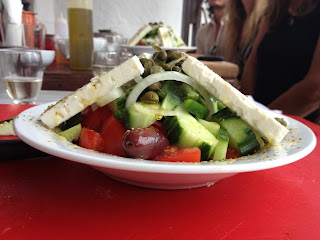Food.
The bane of our existence, yet a part of daily life that’s often overlooked.
How
many of us EBAPers actually know where the tomatoes, cucumbers, onions and
olives in our almost-daily horiatiki salatas (Greek salads) were grown? Or what
wheat was used to make the pasta in the pastitsio that seems to quickly be
devoured once put in front of the group? We may appreciate the Greek cuisine
that fills our stomachs and satiates our hungry, hard-working bodies… but how
connected are we to all of the ingredients that make up the mouth-watering
Greek dishes we so happily consume? All of the moussaka, souvlaki, yemista,
saganaki, and gyros. Sure enough, the list goes on and on.
But of
course dishes of this kind did not always exist. Before all of the casseroles,
grilled meat skewers, baked stuffed vegetables, and pan-fried cheese, diets of
the ancients were much less extravagant. Olives and wheat can be speculated to
be a large part of ancient Greek diets, especially since they had been recorded
on Linear B tablets. Such evidence has been found on tablets mentioning our
site of ancient Eleon, expressing not only their connection with the palace at
Thebes and economic importance in general, but also their eating habits.
But how
is it that we can find out more about the diets of people who lived long before
our grandparent’s time? Sure, written
evidence can plant the seed of our ancient diet and agricultural knowledge, but
it’s the seeds themselves that can tell us stories about the handling and
consumption of food. Through paleobotany, stories about plants and people
spring to life.
First
you must grab a soil sample from the archaeological site in question. Then when
put in water the botanical remains separate from the dirt. Such remains will
float to the surface. The magic of charred seeds can then be explored. Charred
seeds are those that have been subject to hotter-than-humanely-livable
temperatures with a scarce amount of oxygen. These fired up seeds preserve the
state of the seed, preventing decay and damage, allowing paleobotany
enthusiasts to see how food plants were being used in ancient times. Jake, who
opened my eyes to such an art, used glume-based wheats as an example of grain
not often used for bread. It is through examining grain properties that we can
knowledgably speculate how wheat, barley, etc. was processed, stored, and
consumed, and the scale at which this occurred.
And
that my friends, is what Jake would call the “unsexy truth of the Mycenaean
world.” Noting the lack of excitement for the ancient diet of mostly bread and
porridge. Jake’s speedy 5 minute garden talk left my brain with a large spurt
of paleobotany knowledge along with the craving to learn more about the ancient
diet. Although studying charred seeds doesn't give us the full spectrum of eating habits from the past, it gives us a starting point to say the least.
Greek
cuisine and our eating lifestyles in general have shifted significantly since
the times of the Mycenaeans. Maybe the next time we eat a fresh Greek salad
with local ingredients we can think about how fortunate we are to have come
such a long way in our gastronomic endeavors. From growing food plants all the
way to preparation, hard work is involved to feed the hungry stomachs of the
world. Hunger-satisfying meals made with good, wholesome ingredients do more
than give people energy to go about their days; they're integral to culture
and bringing groups of people together, EBAPers included. Learning more about
paleobotany during EBAP will not only open doors of knowledge about ancient
diets, but can hopefully spark a connection with the people of today and the
food that they eat.






